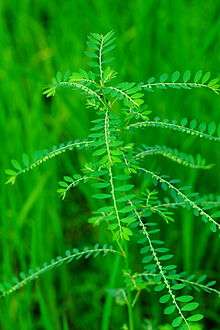Phyllanthus niruri
| Chanca piedra | |
|---|---|
 | |
| Scientific classification | |
| Kingdom: | Plantae |
| (unranked): | Angiosperms |
| (unranked): | Eudicots |
| (unranked): | Rosids |
| Order: | Malpighiales |
| Family: | Phyllanthaceae |
| Genus: | Phyllanthus |
| Species: | P. niruri |
| Binomial name | |
| Phyllanthus niruri L. | |
| Synonyms[1] | |
| |
Phyllanthus niruri is a widespread tropical plant commonly found in coastal areas, known by the common names gale of the wind, stonebreaker or seed-under-leaf. It is a relative of the spurges, belonging to the Phyllanthus genus of Family Phyllanthaceae.
Names
Common names for Phyllanthus niruri include chanca piedra in Spanish, bhumyamalaki in Ayurveda, sampa-sampalukan in Tagalog, and quebra-pedra in Portuguese. The herb is known as nela usiri(నేల ఉసీరీ) in Telugu, keezha nelli (கீழாநெல்லி, an abbreviation of கீழ்க்காய்-நெல்லி, meaning 'berry under') in Tamil, nela nelli(ನೆಲ ನೆಲ್ಲಿ) in Kannada,keezhar nelli in Malayalam . It has many other common names in assorted languages, including dukong anak, dukong-dukong anak, amin buah, rami buah, turi hutan, bhuiaonla, and meniran hijau (in Indonesia), Obukoko in Urhobo language, Nli-ndulie in Ukwani language in Niger-Delta region of Nigeria.
Description
It grows 50–70 cm (20–28 in) tall and bears ascending herbaceous branches. The bark is smooth and light green. It bears numerous pale green flowers which are often flushed with red. The fruits are tiny, smooth capsules containing seeds.
Traditional medicine
Phyllanthus niruri is an important plant of Indian Ayurvedic system of medicine in which it is used for problems of the stomach, genitourinary system, liver, kidney and spleen.[2][3]
Clinical study
P. niruri has been investigated for its potential medicinal benefits, especially in terms of blocking kidney stone formation[4][5][6][7] and anti-hepatitis B activity.[8] However, there is insufficient scientific evidence of its effectiveness; a Cochrane review concluded there is "no convincing evidence that phyllanthus, compared with placebo, benefits patients with chronic HBV infection."[9]
References
- ↑ "The Plant List: A Working List of All Plant Species". Retrieved June 6, 2014.
- ↑ "Keelanelli". Tamilnadu.com. 21 January 2013.
- ↑ Patel, Jay Ram; Tripathi, Priyanka; Sharma, Vikas; Chauhan, Nagendra Singh; Dixit, Vinod Kumar (2011). "Phyllanthus amarus: Ethnomedicinal uses, phytochemistry and pharmacology: A review". Journal of Ethnopharmacology. 138 (2): 286–313. doi:10.1016/j.jep.2011.09.040. PMID 21982793.
- ↑ Nishiura JL, Campos AH, Boim MA, Heilberg IP, Schor N (October 2004). "Phyllanthus niruri normalizes elevated urinary calcium levels in calcium stone forming (CSF) patients". Urological Research. 32 (5): 362–6. doi:10.1007/s00240-004-0432-8. PMID 15221244.
- ↑ Micali S, Sighinolfi MC, Celia A, De Stefani S, Grande M, Cicero AF, Bianchi G (September 2006). "Can Phyllanthus niruri affect the efficacy of extracorporeal shock wave lithotripsy for renal stones? A randomized, prospective, long-term study.". J Urol. 176 (3): 1020–2. doi:10.1016/j.juro.2006.04.010. PMID 16890682.
- ↑ Freitas, A. M.; Schor, N; Boim, M. A. (2002). "The effect of Phyllanthus niruri on urinary inhibitors of calcium oxalate crystallization and other factors associated with renal stone formation". BJU international. 89 (9): 829–34. doi:10.1046/j.1464-410x.2002.02794.x. PMID 12010223.
- ↑ Boim MA, Heilberg IP, Schor N (2010). "Phyllanthus niruri as a promising alternative treatment for nephrolithiasis". International Braz J Urol. 36 (6): 657–64; discussion 664. doi:10.1590/S1677-55382010000600002. PMID 21176271.
- ↑ Keche, Y; Badar, V; Hardas, M (2010). "Efficacy and safety of livwin (polyherbal formulation) in patients with acute viral hepatitis: A randomized double-blind placebo-controlled clinical trial". International Journal of Ayurveda Research. 1 (4): 216–9. doi:10.4103/0974-7788.76784. PMC 3059443
 . PMID 21455448.
. PMID 21455448. - ↑ Xia, Y; Luo, H; Liu, J. P.; Gluud, C (2011). "Phyllanthus species for chronic hepatitis B virus infection". Cochrane Database of Systematic Reviews (4): CD008960. doi:10.1002/14651858.CD008960.pub2. PMID 21491412.
External links
| Wikimedia Commons has media related to Phyllanthus niruri. |
| Wikispecies has information related to: Phyllanthus niruri |